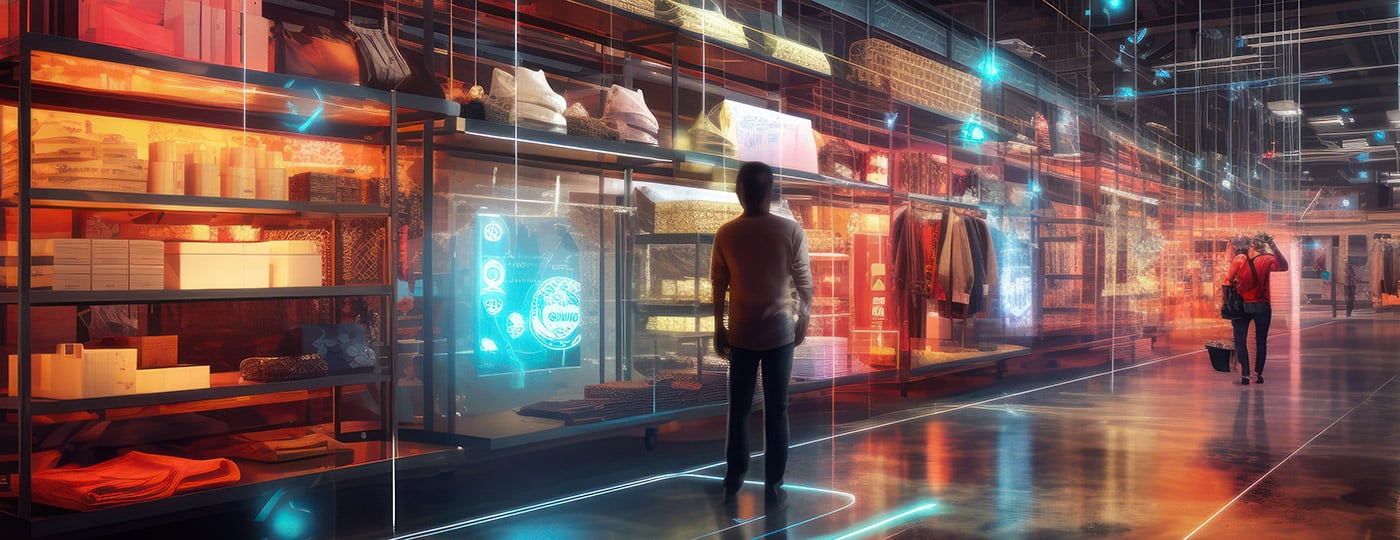Brick and mortar retailers are under tremendous pressure from the e-commerce boom and ever-evolving customer expectations. Globally, online shopping is projected to continue its strong upward trend[1]. A lack of physical constraints has enabled e-commerce sites to innovate often and act quickly in terms of marketing and customer experience. Further, their lower cost of operations has translated into better pricing for customers. As a result, "offline" retailers are suffering from a drop in sales, lower footfalls and a dire need to reinvent themselves to stay relevant.
Retailers are responding with new concepts and digital innovations to transform their role from transactional outlets to experiential destinations. Interactive smart retail technologies are playing an increasing role in this journey, with a variety of tools for retailers to choose from and a broad range of benefits.
In this whitepaper:
Innovate, or Risk Irrelevance
The physical retail store is here to stay, but in different avatars.

First, is a reinvention of the purpose of the offline store. "Future retail is moving from transactional to relational. Brands will use the offline space to create more opportunities for people to connect with the products", says Emilie Colker[2], executive director at IDEO.
For example, brick & mortar retailer Ikea is introducing smaller stores to reach urban shoppers in a bid to compete against e-commerce sites. Ikea is also experimenting with different ways to enable customers to experience products, both in real-life via pop-up cooking classes and virtually via virtual reality apps in Ikea stores.
Second, is the development of a seamless customer experience across online and offline. Over 60% of customers in Germany, the United Kingdom and the United States shop across both physical and digital channels[3], and research suggests that omnichannel shoppers account for a larger percentage of sales[4].
A seamless experience can be as simple as ensuring product pricing is consistent across the retailer's stores, e-commerce site and mobile app. It can also be more complex, where access to online shopping features, like reviews, price comparison and personalized offers, are delivered in-store.
What Customers Want
Online shopping has influenced customer expectations and behaviors.

Customers consume personalized digital content across interactive touch screens (i.e. their smartphones) on a daily basis. Familiar with this technology, they have come to expect smooth user experiences across all facets of life. When it comes to retail experiences, customers expect access to up-to-date product catalogs, detailed product information with supporting rich visual content (like videos), product reviews, price comparison, personalized offers and coupons, and seamless one-click payments.
Customers are also hungry for contemporary technology-fueled experiences, such as virtual reality, nowadays rebranded as the "Metaverse". In a study on "The Future of Shopping" by McKinsey[4] polled customers in Germany, France, the United Kingdom and the United States, and unearthed the following insights:
How Virtual Shelves Work
Virtual shelves are interactive touchscreens that are installed within a certain space, be it inside the store at point of sale, as the shop window, or in a pop-up location. These touchscreens can display products from the retailer's catalog, which customers can interact with as per their will.

Customers can touch the display to see more information about the product, add it to their shopping cart, and complete the transaction digitally or through their smartphone - for instance by scanning a QR code.
Virtual shelves can also play rich media content and can be customized to offer specific services to customers, such as personal assistance. These interactive solutions can also be equipped with product recognition technologies, enabling customers to display relevant additional information when a product is scanned.
A content management system and an array of touchscreen apps and features allow retailers to update content in real-time and ensure the offline store is in 'sync' with their online promotions. All touch interactions can be tracked and analysed to gather intelligence around customers. Virtual shelves can be set up as large multitouch screens, kiosk terminals, tables or even super-sized video walls of different sizes.
Virtual shelves, real results
Interactive technologies point to an exciting future for retail. Several brands have already embraced these technologies and seen positive impact, encouraging others to explore the use of interactive digital signage to find their own sweet spots.

Interactive touchscreens act as a blank digital canvas for retailers to leverage as per their specific needs, be it inventory management, advertising at point of sale, provision of additional information or customer reviews about products and so on. With insight into the specific on-site challenges and some creativity, a diverse range of solutions can be delivered at the POS with interactive virtual shelf solutions
3 Ways that Virtual Shelves Benefit your Business.
Optimise costs, improve customer experience and re-invent the retail experience. The advantages of virtual shelves can be categorised into three key benefits.
Virtual Shelves help Optimise Costs
Virtual Shelves help Improve the Customer Experience
Virtual Shelves help Reinvent the Retail Experience
3 Steps Retailers Can Take To Implement Virtual Shelves
Take-Aways
Smart retail technologies such as virtual shelves are transforming the point of sale and enabling retailers to bridge the digital gap and go even further. Retailers can leverage these technologies to meet customers' demands for up-to-date content, personalised communications and seamless omni-channel shopping, and to delight customers with unique engaging experiences. Virtual shelves and interactive digital technologies can play key roles in freeing up retail space and in facilitating online shopping features in physical stores.

About the Author
Matthias Woggon is CEO & Co-founder of eyefactive GmbH. A pioneer in interactive signage, eyefactive combines interactive touchscreen systems, software and technologies like object recognition to offer innovative solutions for businesses. Furthermore, clients and partners can create ready to use apps with individual content and designs in the world's first ever app store for professional large-scale touchscreens.


